 |
|
 |
|
|
Home →
Publications →
In the News
|
| |
Rugged students learn to rough it
Area tracking school teaches outdoor skills
By CHRIS WADSWORTH
Published by news-press.com on February 5, 2005
Copyright
2005 , The News-PressAs mist rolled off
the Caloosahatchee River, the only sounds that broke the dawn's
silence were the cars speeding down Palm Beach Boulevard about a
mile south.
Then came the shouts, "B-R-E-A-K-F-A-S-T! B-R-E-A-K-F-A-S-T!"
More voices picked up the call, which echoed through the palms and
tall grasses.
Slowly, people began to emerge from the tents that were scattered
along the banks of the water's edge. Among them were a hunter from
Pennsylvania, an office worker from Japan, a former mayoral
candidate from Tennessee and a Cub Scout den leader from Port
Charlotte. They yawned, stretched and lumbered slowly toward the
mess hall beyond a low hill.
Awaiting them was a gruel of lentils and grains.
Welcome to Southwest Florida's newest tourist attraction: Tom
Brown's Tracking, Nature and Wilderness Survival School.
Named after the renowned survivalist, his tracker school has
operated for more than 25 years in the rugged country of southern
New Jersey. But with its sabal palms, alligators and inviting
temperatures, Southwest Florida proved to be an Eden in the fall and
winter, so Brown started classes here in January.
"When it's 15 degrees and icy and (the students) are laying on the
ground and getting snowed on ... their attention span may last an
hour," said Brown, 55. "Look at the weather here. I can get them out
there laying on the lawn."
Brown's school is the latest example of ecotourism in Southwest
Florida, albeit for tourists who thrive on roughing it.
From airboat tours of the Everglades to scuba diving in the Gulf of
Mexico's artificial reefs, tourists' desire to get close to nature
means big bucks to the state. A Florida Fish and Wildlife
Conservation Commission report says the economic impact of hunting,
fishing and wildlife viewing is close to $10 billion per year.
"(Ecotourism) is a very big part of what we're doing and who we
are," said D.T. Minich, the director of tourism for Lee County.
While he was not familiar with the tracker school, Minich said he is
not surprised that Brown and company would want to set up shop in
the region. "Those are the types of things we like to see down here
— rather than an amusement park or a Ripley's Believe it or Not
museum."
CLASS IN SESSION
Brown's tracker school is bound to be another good reason for
tourists to visit Southwest Florida.
With 11 courses scheduled in 2005 and tuition starting at about $900
person, Brown expects to draw nearly 1,000 students, volunteers,
interns and staff to Lee and neighboring counties this year.
"It's really exciting because it's such a different ecosystem," said
instructor Kristy McConnell, 29. "We get to learn new plants and
build shelters with different materials (such as) palm fronds
instead of leaves."
Until Brown finds property to build a school, he runs his survival
program from a rented space at the United Methodist Campground, east
of Alva, just across the Hendry County line.
Brown intends to rehabilitate the land he buys, clearing it of
exotic vegetation in the hopes of restoring some of Florida's
wilderness.
His plan is part of the dual philosophy that permeates the lessons
Brown and his staff teach: hard-core survival skills coupled with an
almost spiritual world outlook.
That philosophy is what lured people such as Johnny Miller, 32, to a
course in January.
"Not everyone is going to (go home) and make fire," said Miller, a
Seattle-area student. "But everybody can have a quieter mind ... and
be more in touch with the Earth and be a steward of the land."
IMPORTANT SKILLS
Miller was among the 60-plus students who came to Southwest Florida
from across the country and abroad to learn from Brown.
They crawled through bushes. They learned to make buckskin clothing
by skinning a deer. They spun a spindle of wood until flames
sparked.
"Thirty-two years in the Army and I learned more in two hours here
(in a lecture) on rocks," said Chris Chenard, 55, a U.S. Army
reservist from Sudbury, Mass. "It's useful stuff. Everything is
designed here toward being practical while being respectful of where
the resources come from."
Ron Medise stood alone under a canopy of tall trees, eating a bland
stew of meat and vegetables.
But Medise, a freshman tracker student who has taken other survival
courses, had a good reason to tough it out — his 11-year-old son.
"We go out on Cub Scout trips and we go over all (the stuff I've
learned). The kids love it," said Medise, a troop den leader from
Port Charlotte. "You show them an animal (track) or how to make a
fire ... and you're the coolest guy in the world."
Medise's wife wasn't as easy to impress — until last August.
"Hurricane Charley came and she was, like, 'Good thing you have that
stove, good thing you know how to start a fire.'
"I was more prepared than some," he said.
http://www.news-press.com/apps/pbcs.dll/article?AID=2005502050501
Copyright
2005 , The News-Press |
|
|
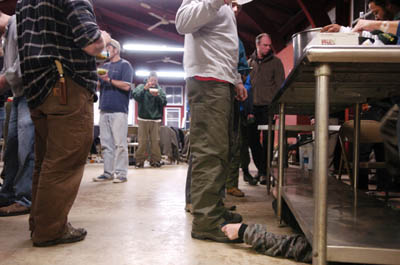 |
Chris
Oelschlager, a volunteer in Tom Brown's Tracking, Nature and
Wilderness Survival School, secretly puts tape on the shoes of a
student. The object is to make students more aware of their
surroundings. |
|
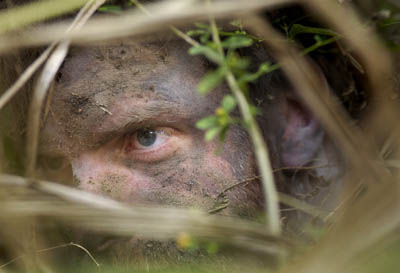 |
Andrew
McMartin, 25, a volunteer with Tom Brown's Tracking, Nature and
Wilderness Survival School, camouflages himself during an exercise.
The purpose was to stay hidden from students. |
|
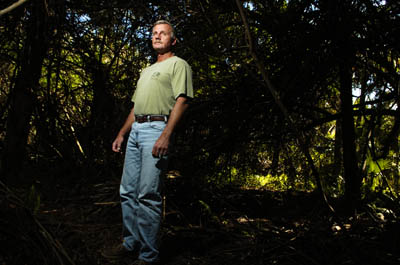 |
Tom Brown
Jr. started the Tom Brown's Tracking, Nature and Wilderness Survival
School 25 years ago in New Jersey. He has moved part of his
operation to Southwest Florida. |
|
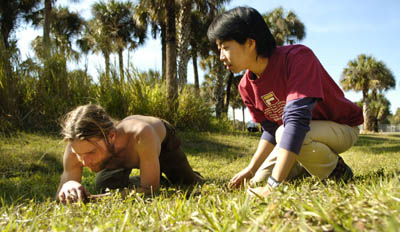 |
Johnny
Miller, 32, from the Seattle area, and Megumi Nakayama, 30, from
Tokyo, Japan learn the art of tracking footsteps during a session at
Tom Brown's Tracking, Nature and Wilderness Survival School at
United Methodist Campground east of Alva. |
|
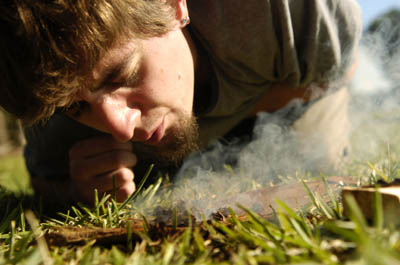 |
Anthony
Ingraldi, 28, from Northfield, Vermont gets a fire started at Tom
Brown's Tracking, Nature and Wilderness Survival School. Ingraldi
made fire by using a bow and rubbing wood together. Flames erupted
seconds later. |
|
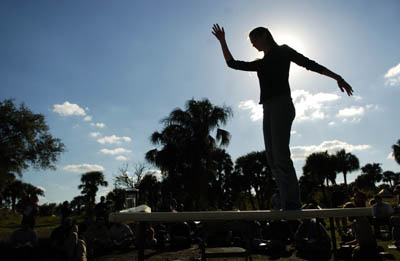 |
Kristy
McConnell, an instructor with Tom Brown's Tracking, Nature and
Wilderness Survival School, teaches the fox walk to students.
|
|
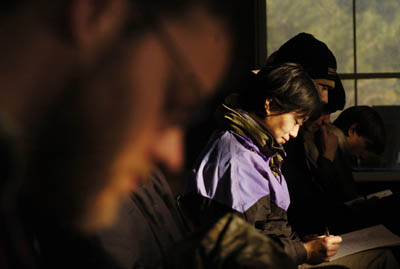 |
Megumi
Nakayama, 30, a student from Japan in Tom Brown's Tracking, Nature
and Wilderness Survival School, takes notes during an early morning
class. Nakayama is an office worker in Japan and came just for this
week long class. |
|
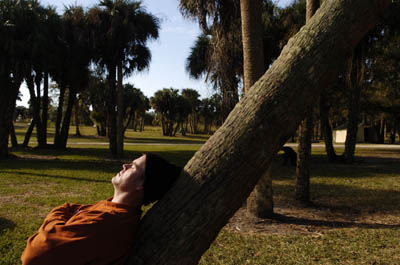 |
Ron Medise,
of Port Charlotte and a student in Tom Brown's Tracking, Nature and
Wilderness Survival School, takes a break in between classes at the
United Methodist Campground. Medis, who has taken other survival
courses, used his skills after Hurricane Charley |
|
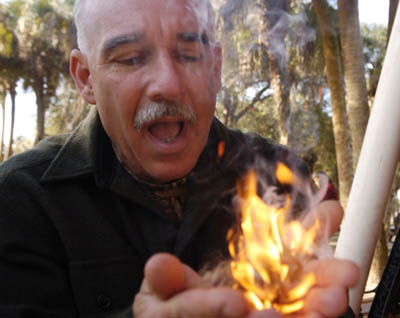 |
Jim
Budzinski, from Lake Worth, gets a fire started in between classes
at Tom Brown's Tracking, Nature and Wilderness Survival School.
|
|
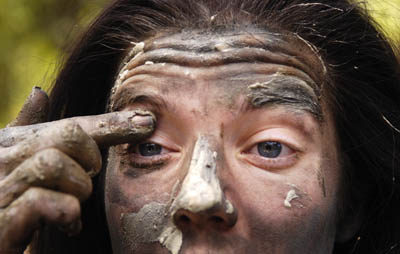 |
Christiane
Desire, 28, a volunteer with Tom Brown's Tracking, Nature and
Survival School, uses charcoal, clay and earth to get into
camouflage during an exercise at the new school at the United
Methodist Campground just east of Alva. |
|
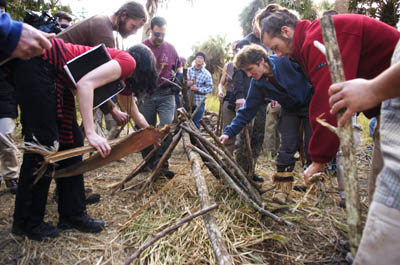 |
Students
in Tom Brown's Tracking, Nature and Wilderness Survival School take
part in building a debris hut. The hut is made up of sticks, palm
fronds and grass and can house one human being during a cold night.
|
|
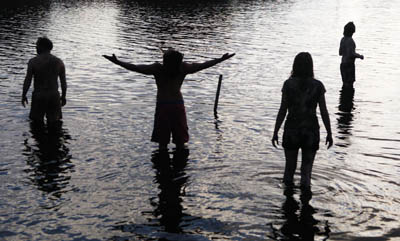 |
From left,
volunteers from Tom Brown's Tracking, Nature and Wilderness Survival
School, Chris Oelschlaeger, 34, Tajj Condon, 28, and Hanna and Rick
Nelson wash off in the Caloosahatchee River after participating in a
camoflouge exercise. |
|
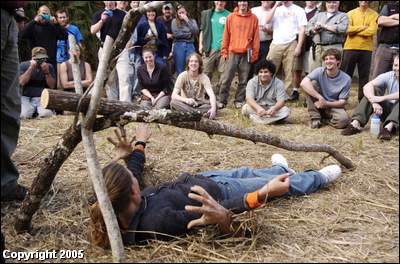 |
The hands of Nihat Tokdil, a volunteer
in Tom Brown's Tracking, Nature and Wilderness Survival School, come
out of the ground and grab Fort Myers student Cassandra Maciag, 29,
during a demonstration on the making of a debris hut. |
|
|
This website has no official or
informal connection to the Tracker School or Tom Brown Jr. whatsoever |
|
|
|
|

